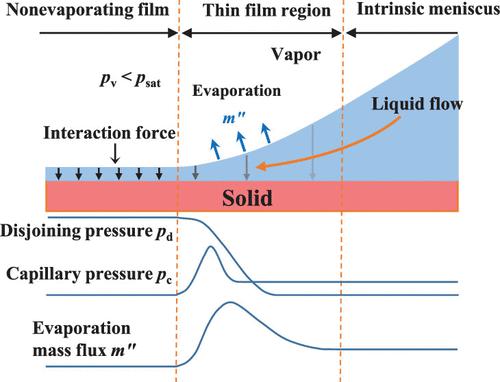Our official English website, www.x-mol.net, welcomes your
feedback! (Note: you will need to create a separate account there.)
Mesoscopic Model for Disjoining Pressure Effects in Nanoscale Thin Liquid Films and Evaporating Extended Meniscuses
Langmuir ( IF 3.7 ) Pub Date : 2023-09-07 , DOI: 10.1021/acs.langmuir.3c02068 Zhiheng Hu 1 , Shuai Gong 1
Langmuir ( IF 3.7 ) Pub Date : 2023-09-07 , DOI: 10.1021/acs.langmuir.3c02068 Zhiheng Hu 1 , Shuai Gong 1
Affiliation

|
Disjoining pressure effect is the key to describe contact line dynamics, micro/nanoscale liquid–vapor phase change heat transfer, and liquid transport in nanopores. In this paper, by combining a mesoscopic approach for nanoscale liquid–vapor interfacial transport and a mean-field approximation of the long-range solid–fluid molecular interaction, a mesoscopic model for the disjoining pressure effect in nanoscale thin liquid films is proposed. The capability of this model to delineate the disjoining pressure effect is validated. We demonstrate that the Hamaker constant determined from our model agrees very well with molecular dynamics (MD) simulation and that the transient evaporation/condensation mass flux predicted by this mesoscopic model is also consistent with the kinetic theory. Using this model, we investigate the characteristics of the evaporating extended meniscus in a nanochannel. The nonevaporating film region, the evaporating thin-film region, and the intrinsic meniscus region are successfully captured by our model. Our results suggest that the apparent contact angle and thickness of the nonevaporating liquid film are self-tuned according to the evaporation rate, and a higher evaporation rate results a in larger apparent contact angle and thinner nonevaporating liquid film. We also show that disjoining pressure plays a dominant role in the nonevaporating film region and suppresses the evaporation in this region, while capillary pressure dominates the intrinsic meniscus region. Strong evaporation takes place in the thin-film region, and both the disjoining pressure and capillary pressure contribute to the total pressure difference that delivers the liquid from the intrinsic meniscus region to the evaporating thin-film region, compensating for the liquid mass loss due to strong evaporation. Our work provides a new avenue for investigating thin liquid film spreading, liquid transport in nanopores, and microscopic liquid–vapor phase change heat/mass transfer mechanisms near the three-phase contact line region.
中文翻译:

纳米级薄液膜中分离压力效应和蒸发扩展弯月面的介观模型
分离压力效应是描述接触线动力学、微/纳米级液-汽相变传热和纳米孔中液体传输的关键。在本文中,通过结合纳米级液-气界面传输的介观方法和长程固-液分子相互作用的平均场近似,提出了纳米级薄液膜中分离压力效应的介观模型。该模型描述分离压力效应的能力得到了验证。我们证明,根据我们的模型确定的 Hamaker 常数与分子动力学 (MD) 模拟非常吻合,并且该介观模型预测的瞬态蒸发/冷凝质量通量也与动力学理论一致。使用该模型,我们研究了纳米通道中蒸发延伸弯月面的特征。我们的模型成功捕获了非蒸发薄膜区域、蒸发薄膜区域和本征弯月面区域。我们的结果表明,非蒸发液膜的表观接触角和厚度根据蒸发速率进行自调节,蒸发速率越高,表观接触角越大,非蒸发液膜越薄。我们还表明,分离压力在非蒸发膜区域中起主导作用,并抑制该区域的蒸发,而毛细管压力在固有弯月面区域中占主导地位。 薄膜区域发生强烈蒸发,分离压力和毛细管压力共同形成总压差,将液体从固有弯月面区域输送到蒸发薄膜区域,补偿由于蒸发而造成的液体质量损失。蒸发强烈。我们的工作为研究薄液膜铺展、纳米孔中的液体传输以及三相接触线区域附近的微观液-汽相变传热/传质机制提供了新途径。
更新日期:2023-09-07
中文翻译:

纳米级薄液膜中分离压力效应和蒸发扩展弯月面的介观模型
分离压力效应是描述接触线动力学、微/纳米级液-汽相变传热和纳米孔中液体传输的关键。在本文中,通过结合纳米级液-气界面传输的介观方法和长程固-液分子相互作用的平均场近似,提出了纳米级薄液膜中分离压力效应的介观模型。该模型描述分离压力效应的能力得到了验证。我们证明,根据我们的模型确定的 Hamaker 常数与分子动力学 (MD) 模拟非常吻合,并且该介观模型预测的瞬态蒸发/冷凝质量通量也与动力学理论一致。使用该模型,我们研究了纳米通道中蒸发延伸弯月面的特征。我们的模型成功捕获了非蒸发薄膜区域、蒸发薄膜区域和本征弯月面区域。我们的结果表明,非蒸发液膜的表观接触角和厚度根据蒸发速率进行自调节,蒸发速率越高,表观接触角越大,非蒸发液膜越薄。我们还表明,分离压力在非蒸发膜区域中起主导作用,并抑制该区域的蒸发,而毛细管压力在固有弯月面区域中占主导地位。 薄膜区域发生强烈蒸发,分离压力和毛细管压力共同形成总压差,将液体从固有弯月面区域输送到蒸发薄膜区域,补偿由于蒸发而造成的液体质量损失。蒸发强烈。我们的工作为研究薄液膜铺展、纳米孔中的液体传输以及三相接触线区域附近的微观液-汽相变传热/传质机制提供了新途径。

















































 京公网安备 11010802027423号
京公网安备 11010802027423号